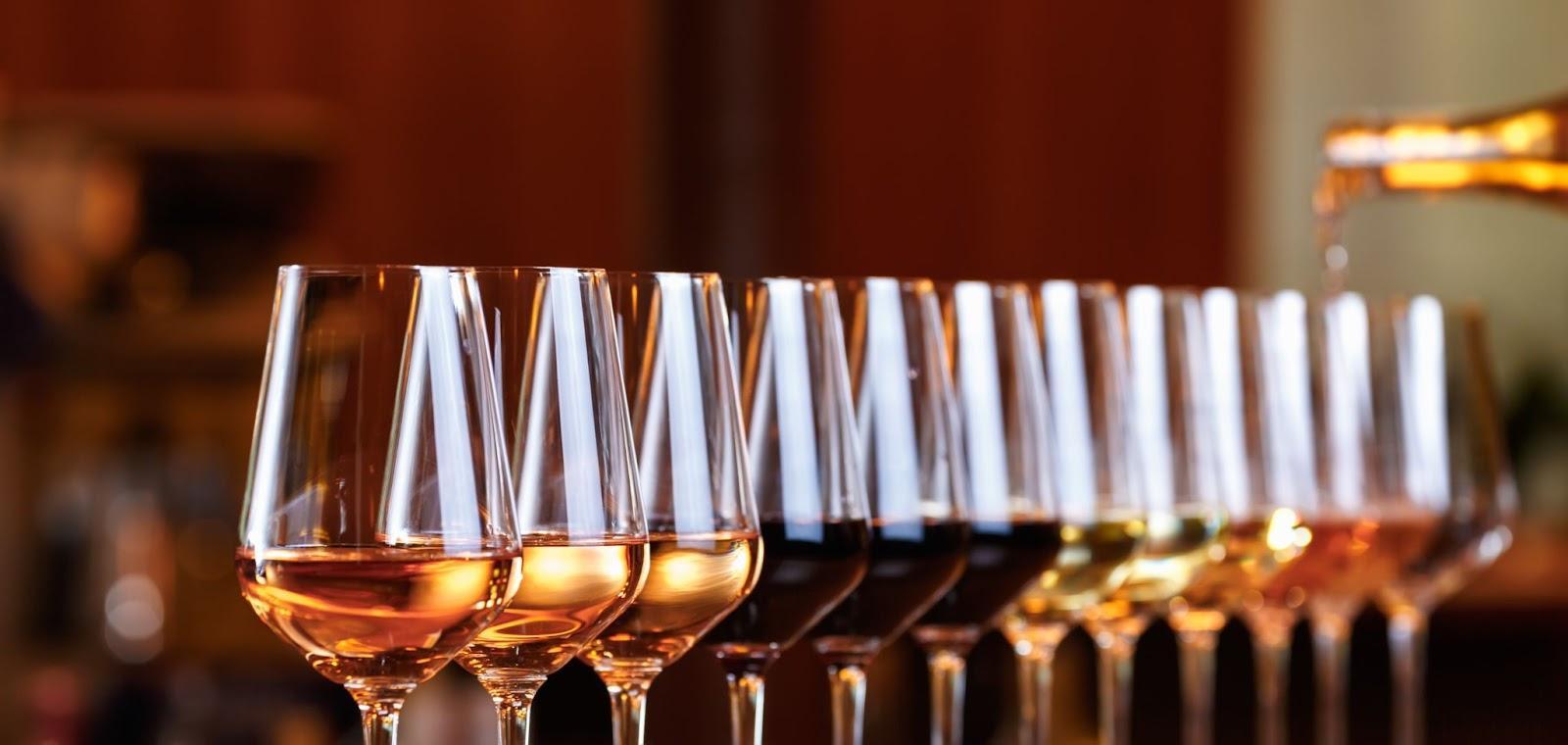- Wine Color/Type
- Top Occasions
- Unique Wines
- Surprise Me!
2024 New Years Resolution: Understanding Wine Basics
Let us begin by wishing you Happy New Year! All the VinoVoss team is happy to help you with your wine journey, even if that begins today! That’s why we’ve come up with a speed course on wine!
Understanding wine can increase your appreciation. (Photo: Pixel-Shot/stock.adobe.com)
The majority of us are looking for New Year's resolutions. Some want to lose weight, others aim to compete in sports, and still others strive to try to avoid alcohol for the year. At VinoVoss, we recommend the 'wine-educational' resolution.
In addition to evaluating wine and becoming a knowledgeable taster and commentator, our cheat sheet sets you up with its six fundamental elements. These wine attributes are paramount in understanding wine: sweetness, acidity, tannins, alcohol, body, and length. Think about these next time you're at a wine tasting!
Sweetness
The sweetness represents the residual sugar (RS) after the fermentation process. Most wines undergo fermentation until they reach dryness, typically containing less than 2 g/L RS. This makes them dry wines.
Sometimes winemakers use rectified grape must concentrate (RCGM), a concentrated grape juice, to adjust the balance. This practice is common in entry-level wines.
Dessert wines, often produced from types of grapes affected by noble rot, offer a more syrupy consistency. The character of sweet wines becomes visual when swirling the wine in a glass, revealing a denser liquid. You can observe the 'legs' or 'tears' of the wine, which form from the glycerol in the wine's sugar and alcohol content.
The speed at which these legs move and their width can offer clues about the wine's sweetness and alcohol level. Slower-moving, wider legs suggest a sweeter wine with higher alcohol content. To tell sweetness and alcohol content just by looking at the legs is hard; they mainly help you make a decision.
More Than One Type of Acidity
Wine's acidity is important and comes from three acids: malic acid, tartaric acid, and lactic acid. They give wine its sharp, refreshing, and soft tastes. Each type plays a significant role in shaping the wine's mouthfeel and texture.
Malic Acid
Wines from warmer climates commonly associate malic acid, which tends to be present in lower concentrations. Wines from colder regions or made with early-harvested grapes have more malic acid, making them more acidic. This sharpness is a defining feature of wines that embrace their natural acidity, such as those from colder growing areas.
Tartaric Acid
As grapes mature, the levels of malic acid decrease while tartaric acid, another key component, becomes more prominent. Tartaric acid is notable for contributing to the pleasant crisp texture of wines like Sauvignon Blanc. The balance between malic and tartaric acid levels is essential in achieving the desired acidity profile in a wine.
Lactic Acid
Lactic acid is perhaps best recognized in the context of buttery Chardonnays. This softer, creamier acid is the result of malolactic fermentation (MLF), a process that occurs either during or after primary fermentation. MLF converts the sharper malic acid into the softer lactic acid, imparting a buttery or creamy texture to the wine. This transformation can also introduce nuances of hazelnut flavors, adding complexity to the wine's profile.
Getting the Balance Right
To consider a wine high-quality, it must exhibit a harmonious balance between sweetness and acidity. A wine that is overly sweet with low acidity can appear dull and uninteresting.
A wine with tangy acidity can create a delicious mix of flavors. This happens when it is balanced with a bit of sugar. It enhances the tasting experience and makes it better.
Tannins
Tannins in wine are similar to those found in tea, contributing a slight bitterness and a sensation often perceived in the gums or at the back of the mouth. The texture of tannins can range from very tannic and grippy to moderate and smooth. Over time, tannins evolve from a sandy to a grainy texture.
Alcohol and Body
The alcohol content in wine is closely linked to its body. Alcohol contributes to the wine's weight and mouthfeel, which is often confused with the wine's intensity. While intensity refers to the concentration of aromas, the body is more about the wine's lightness or richness on the palate.
For instance, a light-bodied wine like a Riesling Kabinett with 7.5% ABV and 25 g/L residual sugar contrasts sharply with a full-bodied Primitivo at 15% ABV.
Length Matters
The length of a wine, often seen as a key indicator of its quality, refers to the duration for which the wine's flavors linger on the palate after tasting. Generally, a longer persistence is equated with higher quality.
While some may consider an acidic or bitter aftertaste as part of the length, the focus should primarily be on the duration of the aromatic flavors. A wine that leaves a lasting, pleasant impression typically signifies a well-crafted product.
Every wine is unique. (Photo: Ekaterina_Molchanova/stock.adobe.com)
Evaluating and Tasting Wine: A Step-by-Step Approach
To fully appreciate a bottle of wines quality, there are essential steps to follow:
Visual Assessment:
Color Analysis
Begin by observing the wine's color. This can give clues about the wine's age, grape variety, and potential flavor profiles.
Glass Tilting
Tilt the glass and examine the wine against a light source. Pay attention to the center and the rims. Browning edges might indicate an older vintage or possible oxidation.
The color of wine can give you a feeling of the grape variety. A Pinot Noir might be brighter than a full-bodied Cabernet Sauvignon.
This is due that the color is extracted from the grape skins. Depending on the style of wines produced, a Pinot Noir could also be blended with a dark variety. Caution is advised.
Bubbles in Sparkling Wines
For sparkling wines, observe the bubbles. High-quality sparkling wines often feature slower-rising bubbles, while a Frizzante style typically has smaller, quicker-rising bubbles. This can be a subtle indicator of the wine's quality and method of production.
Nosing the Wine:
Concentration
Take a moment to sniff the wine and consider the concentration of the aroma. Is it faint, moderate, or intense? This can provide insights into the wine's character and complexity.
Aroma Identification
Try to identify the specific aromas present. Are they fruity, floral, earthy, or perhaps spicy? Which type of wine is it?
The Taste Test:
When assessing the quality of wine, the most fundamental question is whether you enjoy it. This subjective aspect forms the core of wine appreciation.
However, for a more in-depth analysis, one can employ the "BLIC-Method," which stands for Balance, Length, Intensity, and Complexity. This method provides a structured approach to evaluating a wine's characteristics.
Balance
Balance is key in evaluating a wine. It involves considering how various elements like sugar, acids, tannins, fruit, and oak integration harmonize with each other. A well-balanced wine will have these components in a pleasing proportion, with none overpowering the others.
Length
The length refers to how long the flavors of the wine linger on the palate. A longer finish is often associated with higher quality, as it suggests a complexity and richness of flavors that persist after tasting.
Intensity
Intensity is about the strength of the wine's aromas and fruit flavors. However, higher intensity is not always better. The ideal intensity should complement the wine's body – a light-bodied wine with moderate intensity can be more appealing than a full-bodied wine with weak fruit intensity.
Complexity
Complexity in wine is characterized by the range and intricacy of aromas and flavors it presents. These can be categorized into primary, secondary, and tertiary aromas:
Primary Aromas
These are derived from the grape variety and include scents like citrus fruits, apples, floral notes, and other fresh fruits.
Secondary Aromas
These develop during the winemaking process. Aromas like coconut or vanilla from oak maturation, along with almond, salt, and dairy notes, fall into this category.
Tertiary Aromas
These evolve over time, after the wine has been bottled. They can include balsamic, savory, or tobacco notes, adding depth and complexity to the wine.
If you’re looking for an aroma inspiration, you can print our an “Aroma Wheel”. This will help you explore the wine in greater detail. Secondary and tertiary notes are not always desirable in young, fruit-forward wines, where the emphasis is on the fresh, primary fruit characteristics.
Evaluating a wine's quality requires practice and patience. Your resolution will improve your wine knowledge and make each glass more enjoyable. When tasting different wines, keep in mind that the most crucial factor is your personal enjoyment and the experiences they provide.
With a little practice you can differ the good wine from the outstanding. With some time other wine drinkers will be looking up to you for guidance.
To succeed in your journey of becoming a great wine taster with refined taste buds, stay connected to our VinoVoss blog, as we provide daily tips and expert knowledge to empower your wine recommendations.
Peter Douglas
Latest articles


